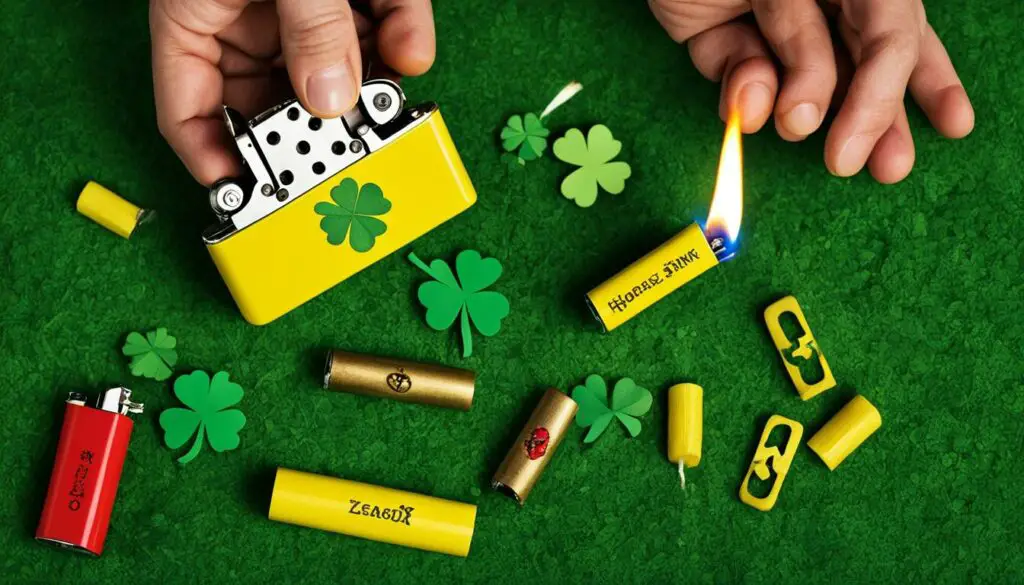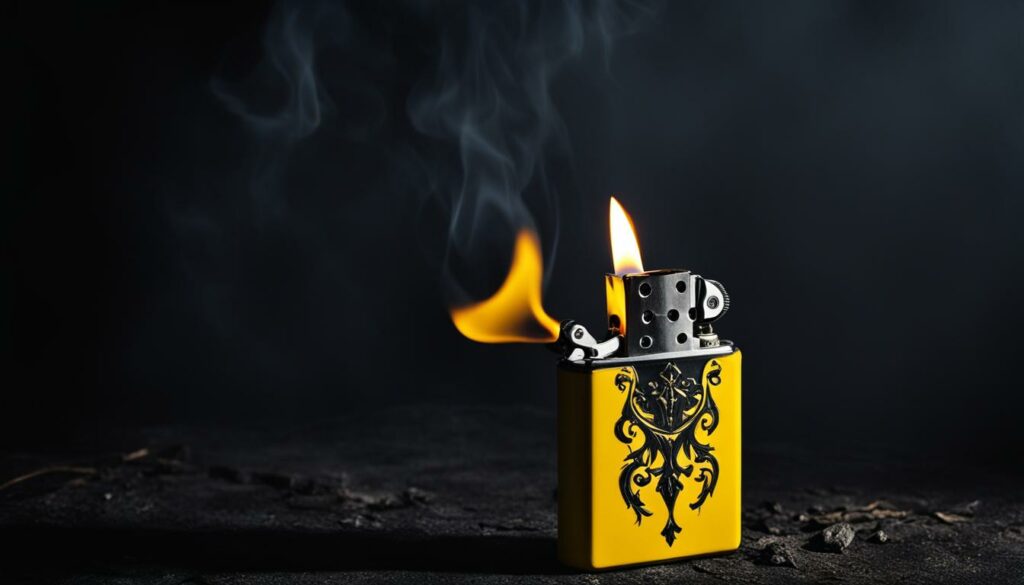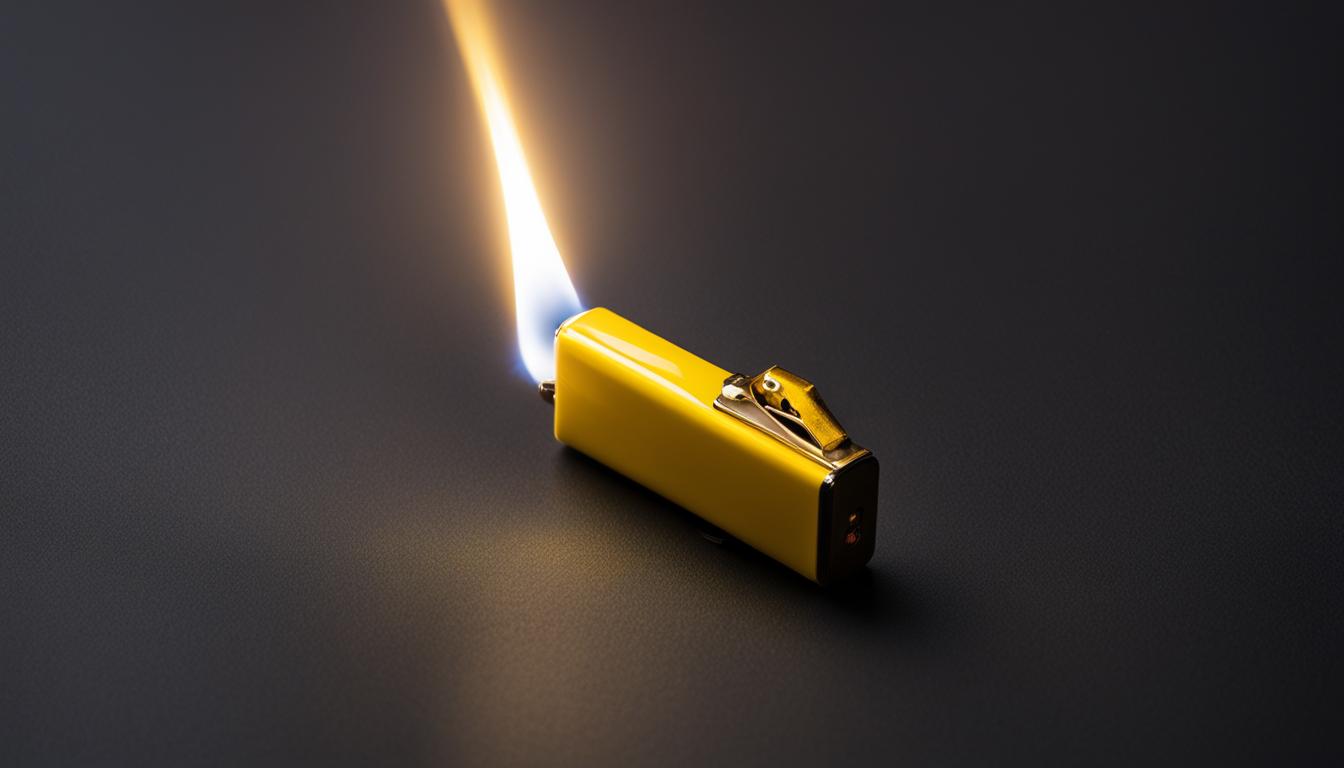The belief that yellow lighters bring bad luck is a common superstition. Many people associate yellow lighters with negative outcomes and misfortune. However, it is important to determine whether this belief is based on factual evidence or if it is simply a myth passed down through generations. Let’s explore the origins and reasoning behind this superstition to see if there is any truth to it.
Key Takeaways:
- Yellow lighters have long been associated with bad luck and superstitions.
- The belief in yellow lighters bringing bad luck is not based on concrete evidence.
- Superstitions can influence people’s behavior and perception of luck.
- Challenging superstitions with rational thinking can help overcome unfounded fears.
- Cultural differences can shape beliefs and superstitions relating to yellow lighters.
The Origins of the Yellow Lighter Superstition

The superstition surrounding yellow lighters has its roots in an intriguing urban legend that has captured the imagination of many. According to the legend, several influential musicians, including Janis Joplin, Jimi Hendrix, Kurt Cobain, and Jim Morrison, all tragically passed away at the age of 27 while in possession of a white lighter.
“The legend of musicians dying at 27 with a white lighter is what kickstarted the belief in unlucky lighters.”
This urban legend became intertwined with the belief that any lighters without stickers, which are often white, bring misfortune. Over time, people expanded this belief to include yellow lighters as well, possibly due to their visual similarity to the ill-fated white lighters.
While it is important to approach superstitions with skepticism and critical thinking, understanding their origins can shed light on the development and perpetuation of such beliefs.
Unraveling the Folklore
As folklore often evolves and adapts over time, it is crucial to recognize that the belief in the curse of yellow lighters may vary across different cultures and regions. Superstitions can be deeply influenced by cultural factors, upbringing, and personal experiences, resulting in a diverse range of beliefs surrounding yellow lighters.
“Cultural differences shape superstitions, contributing to the varying beliefs in different regions.”
For instance, some regions associate different colors with bad luck, such as white lighters being considered unlucky in certain areas. This variation highlights the subjective nature of superstitions and how they reflect the cultural nuances of the communities that hold them.
As the belief in yellow lighters’ curse persists in certain corners of society, it is essential to explore the psychology and influence behind these superstitions. By understanding their impact, individuals can better navigate their own beliefs and approach superstitions with a rational mindset.
Debunking the Yellow Lighter Myth

Despite the widespread belief that yellow lighters bring bad luck, there is no factual basis to support this superstition. Superstitions are often based on anecdotes and personal experiences rather than concrete evidence. Many people who have used yellow lighters have reported no negative consequences or bad luck. As society progresses and becomes more skeptical of superstitions, the perception of yellow lighters as bad luck may be changing.
Let’s take a closer look at the evidence and reasoning behind the belief that yellow lighters are bad luck. While many superstitions have deep roots in cultural traditions and folklore, they often lack scientific validation.
Like other superstitions, the notion that yellow lighters bring bad luck is subjective and varies among individuals. Some may attribute unfortunate events to the use of a yellow lighter, while others may have positive experiences without any negative consequences. The power of perception and personal beliefs play a significant role in shaping our views on superstitions.
It’s important to approach superstitions with skepticism and critical thinking. Rather than blindly accepting the belief that yellow lighters bring bad luck, consider the lack of concrete evidence supporting this notion. Instead, focus on rational thinking and scientific inquiry to distinguish fact from fiction.
In recent years, there has been a shift towards questioning and challenging superstitions, including the belief in yellow lighters as bad luck. As society becomes more educated and rational, individuals are relying less on unfounded beliefs and more on evidence-based reasoning.
“The perception of yellow lighters as bad luck is gradually changing as people become more skeptical and seek logical explanations.”
Changing Perceptions: Debunking the Yellow Lighter Myth
Let’s take a closer look at some common arguments against the belief in yellow lighters as bad luck:
- Anecdotal Evidence: Many individuals who have used yellow lighters report no adverse experiences or negative consequences. Personal accounts can provide valuable insight into the lack of correlation between yellow lighters and bad luck. Without concrete evidence, it’s essential to question the validity of this superstition.
- Confirmation Bias: The belief in yellow lighters as precursors of misfortune can be attributed to confirmation bias. People tend to remember events that confirm their beliefs and overlook those that don’t. This cognitive bias may contribute to the perpetuation of the yellow lighter myth.
- Cultural Variation: Superstitions, including the belief in yellow lighters as bad luck, can vary across cultures and regions. What may be considered unlucky in one culture may not hold the same significance in another. Understanding the cultural context is crucial in evaluating the validity of superstitions.
- Psychological Factors: Superstitions often arise from a psychological need for control and understanding. Ascribing bad luck to yellow lighters may provide a sense of explanation for unpredictable events. However, it’s important to distinguish between psychological comfort and factual evidence.
- Scientific Research: Scientific studies have not found any causal relationship between the color of a lighter and luck or fortune. The lack of empirical data further challenges the belief in yellow lighters bringing bad luck.
| Arguments Against the Yellow Lighter Myth | Counterarguments Supporting the Myth |
|---|---|
| Anecdotal evidence shows that many people have used yellow lighters without experiencing any bad luck. | Some individuals may claim specific incidents in which they believe a yellow lighter brought them bad luck. |
| Confirmation bias can influence individuals to attribute negative events to the use of a yellow lighter. | People tend to remember and emphasize instances of bad luck associated with yellow lighters, reinforcing the belief. |
| Cultural differences demonstrate that the belief in yellow lighters as bad luck varies across different regions. | In certain cultures or communities, the belief in yellow lighters as bad luck remains prevalent and deeply ingrained. |
| Psychological factors, such as a need for control and explanation, can contribute to the belief in yellow lighters as bad luck. | Some individuals find comfort in attributing misfortune to external factors, such as the color of a lighter. |
| Scientific research has not found any correlation between the color of a lighter and luck. | The lack of scientific evidence does not definitively prove or disprove the belief in yellow lighters as bad luck. |
The Influence of Superstitions on Behavior

Superstitions have a fascinating way of shaping our behavior, even if we don’t wholeheartedly believe in them. The belief that yellow lighters bring bad luck is no exception. This superstition can influence an individual’s decision to use or avoid yellow lighters altogether. Similar to other superstitions like avoiding walking under ladders or breaking mirrors, the fear of bad luck can be deeply ingrained in certain individuals. As a result, they may choose to steer clear of yellow lighters out of caution.
While skepticism may prevail among many, it can’t be denied that the power of superstitions can play a significant role in decision-making. It’s intriguing to observe the influence these beliefs hold over us, even when faced with evidence to the contrary. Let’s explore the impact of the yellow lighter superstition on our behavior and decision-making processes.
“It’s just incredible how superstitions can influence our actions. Even though I know it’s all nonsense, I can’t help but feel a twinge of unease whenever I see a yellow lighter.” – Amy, a non-superstitious individual
It’s important to note that superstitions can vary greatly from person to person. For some, yellow lighters may hold no significance whatsoever, while for others, the belief in their connection to bad luck remains steadfast.
Impact on Decision-Making
The belief that yellow lighters bring bad luck can subconsciously impact an individual’s behavior. Even if they don’t truly hold the belief, the influence of cultural narratives and personal experiences can’t be disregarded. This may lead individuals to choose an alternative lighter, opt for different methods of ignition, or even borrow lighters from others to avoid the perceived consequences of using a yellow lighter.
Furthermore, the fear of bad luck can extend beyond personal use. For instance, some individuals may actively discourage others from using yellow lighters or feel discomfort when someone in their vicinity does so. These behaviors are a result of the underlying belief in the superstition, whether consciously acknowledged or not.
The Psychology Behind Superstitions
Superstitions, including the belief in yellow lighters as bad luck, often arise from a fundamental human desire to control or make sense of unpredictable events. They provide a sense of order, offering comfort and certainty in an uncertain world. The psychological and cognitive benefits associated with superstitions contribute to their lasting power, despite the lack of evidence supporting their validity.
Superstitions can be seen as a way for our minds to create connections and patterns, even when none exist in reality.
Breaking Free from Superstitions
Overcoming superstitions, including the belief in the unlucky nature of yellow lighters, is a personal journey that requires self-reflection and open-mindedness. Challenging deeply ingrained beliefs can be difficult, but with education and an evidence-based approach, individuals can gradually let go of these irrational fears. It’s important to approach superstitions with a healthy dose of skepticism and critical thinking, relying on logical reasoning rather than anecdotal experiences or unfounded beliefs.
The Power of Perception
Perception plays a significant role in the validity and perpetuation of superstitions. When it comes to the belief in yellow lighters as bad luck, individuals may interpret events in a way that confirms their beliefs, further reinforcing the superstition. This self-fulfilling prophecy can strengthen the conviction in the belief system, making it difficult for individuals to break free from its grip.
By challenging our perception and questioning the validity of superstitions, we can shift towards a more rational and evidence-based approach to decision-making, free from the limitations of unfounded beliefs and superstitions.
The Psychology Behind Superstitions
Superstitions often arise from a deep-seated desire to control or make sense of the unpredictable events that occur in our lives. They provide a sense of comfort and certainty in an uncertain world. The belief in the power of yellow lighters to bring bad luck is no exception.
For some individuals, the superstition surrounding yellow lighters may serve as a way to rationalize unfortunate or negative events that they have experienced. By attributing their misfortunes to the use of a yellow lighter, they create a sense of order and explanation in an otherwise chaotic world.
“It’s not just a coincidence that something bad happened when I used a yellow lighter. The yellow lighter brings bad luck, and that’s why it happened.”
However, it is important to recognize that superstitions are not based on scientific evidence or logical reasoning. They are often passed down through generations and perpetuated by anecdotal experiences.
While superstitions can provide a sense of security and control, it is crucial to approach them with skepticism and critical thinking. The belief that yellow lighters bring bad luck is not supported by any factual basis. It is merely a myth that has been ingrained in popular culture.
By questioning the validity of superstitions and relying on scientific evidence, individuals can debunk the myth surrounding yellow lighters and make decisions based on rational thinking.
Next, we will explore the cultural differences in superstitions related to yellow lighters and the power of perception.
The Cultural Differences in Superstitions

Superstitions vary across cultures and regions, shaping individuals’ beliefs and perceptions. The belief in the unlucky nature of yellow lighters may be more prevalent in certain areas, while other regions associate different colors with bad luck. Cultural factors, upbringing, and personal experiences all play a role in the formation of superstitions.
It is interesting to note that yellow lighters, which are often associated with bad luck, have their own unique folklore in different societies. In some regions, yellow is believed to represent prosperity, happiness, or even protection from evil spirits. This variation in superstitions not only reflects the subjectivity of beliefs but also underscores the powerful influence of culture on the way we interpret symbols and signs.
For example, in many Asian cultures, the color yellow is associated with wealth, joy, and vitality. Therefore, the perception of yellow lighters as unlucky may be quite different in these regions. It goes to show that superstitions are deeply rooted in the collective consciousness and can differ significantly from one culture to another.
The Cross-Cultural Variations in Beliefs
To illustrate the cultural differences in superstitions, let’s take a closer look at a few examples:
- In Western cultures, black cats are often seen as a symbol of bad luck, while in many Eastern cultures, they are considered a sign of good fortune and protection.
- In some parts of Europe, breaking a mirror is believed to bring seven years of bad luck, whereas in many Asian cultures, a broken mirror is seen as a sign of renewal and the end of misfortune.
- While knocking on wood is commonly practiced in Western cultures to ward off bad luck, in many African cultures, it is believed that spirits reside in trees, so knocking on wood is seen as a way to gain their favor and protection.
As you can see, the perception of luck and superstitions can vary greatly depending on cultural backgrounds. These differences not only provide an interesting insight into the diverse beliefs around the world but also highlight the importance of cultural context when examining superstitions.
“Superstition is the poetry of life, whereas science is the prose.”
| Culture | Perception of Yellow Lighters |
|---|---|
| Western | Associated with bad luck and misfortune |
| Eastern | Symbolizes prosperity, happiness, or protection |
| Asian | Associated with wealth, joy, and vitality |
The Power of Perception
Superstitions can be powerful influencers on people’s behavior and beliefs. One such superstition is the belief that using a yellow lighter brings bad luck. While this belief has no factual basis, individuals who hold this superstition may interpret events in a way that confirms their beliefs, leading to a self-fulfilling prophecy.
If someone firmly believes in the yellow lighter belief, they may more easily notice negative occurrences when using a yellow lighter and attribute them to the superstition. This power of perception can reinforce their belief in the superstition, even though there is no actual causal link between using a yellow lighter and experiencing bad luck.
“The power of perception” – If someone believes that using a yellow lighter will bring bad luck, they may more easily notice negative occurrences when using it and attribute them to the superstition.
It’s important to consider the role of perception when evaluating the validity of superstitions, including the belief in yellow lighters being bad luck. Our minds have a tendency to seek patterns and connections, even when they may not exist. This cognitive bias can lead us to attribute significance to coincidental events, reinforcing our superstitious beliefs.
To overcome the power of perception and debunk the yellow lighter superstition, it is crucial to approach it with rational thinking and critical analysis. By questioning the belief and seeking scientific evidence, we can break free from the grip of irrational fears and make informed decisions based on facts rather than superstition.
| Perception | Reality |
|---|---|
| Belief in yellow lighter belief | No factual basis |
| Interpretation of negative occurrences as confirmation | No causal link between yellow lighters and bad luck |
| Reinforcement of superstition | Understanding the role of perception in shaping beliefs |
| Overcoming superstitions through critical thinking |
The Role of Rational Thinking

In order to debunk superstitions and dispel false beliefs, it is crucial to employ rational thinking and critical analysis. When examining the belief that yellow lighters bring bad luck, it is essential to rely on scientific evidence and logical reasoning rather than anecdotal experiences or unfounded beliefs.
Rather than accepting superstitions at face value, it is important to challenge them and question their validity. By doing so, individuals can make more informed decisions and avoid unnecessary fears or irrational behaviors.
“We must question the story logic of having an all-knowing all-powerful God, who creates faulty humans, and then blames them for his own mistakes.”
– Gene Roddenberry –
By critically examining the superstition surrounding yellow lighters, we can begin to change perceptions about their supposed negative influence. It is through rational thinking that we can debunk the yellow lighter superstition and encourage a more evidence-based approach to decision-making.
The Power of Scientific Evidence
Scientific evidence plays a crucial role in debunking superstitions and separating fact from fiction. When evaluating the belief in yellow lighters as bad luck, it is important to consider empirical research and studies.
- Scientific studies have consistently shown that there is no causal relationship between yellow lighters and bad luck.
- Research has demonstrated that superstitions are often the result of cognitive biases and associative thinking rather than objective reality.
- Psychological studies have revealed that the perception of bad luck associated with yellow lighters is a product of confirmation bias, where individuals attribute negative events to the superstition while ignoring positive outcomes.
By relying on scientific evidence and logical reasoning, we can reject the unfounded belief in yellow lighters as bringers of bad luck. It is important to challenge superstitions with critical thinking and base our beliefs on verifiable facts rather than hearsay or tradition.
Embracing Rationality and Skepticism
To overcome the yellow lighter superstition, it is crucial to embrace rationality and skepticism. This entails questioning and critically examining the validity of beliefs, especially those rooted in superstition or tradition.
Rather than succumbing to irrational fears or following beliefs without evidence, adopting a rational and skeptical mindset allows individuals to make informed choices based on reason and evidence.
By debunking the yellow lighter superstition through rational thinking, we can change perceptions and encourage others to approach superstitions with a healthy dose of skepticism. Let us strive for a society that values reason and evidence, ensuring that our decisions are guided by facts rather than unfounded beliefs.
Overcoming Superstitions

Overcoming superstitions is a personal journey that requires self-reflection and open-mindedness. It’s important to educate yourself about the origins and lack of evidence for certain superstitions, including the belief in yellow lighters as bad luck. By challenging deeply ingrained beliefs, you can begin to let go of irrational fears and embrace a more rational and evidence-based approach to decision-making.
Changing your perspective and questioning superstitions that have no factual basis is key to overcoming them. By understanding that superstitions are often rooted in anecdotes and personal experiences rather than concrete evidence, you can start to break free from their grasp.
Remember, using a yellow lighter does not bring bad luck. It’s simply a colorful myth that holds no true power over your life.
The Power of Knowledge
Educating yourself about the origins and reasoning behind superstitions can help you overcome them. By exploring the history and cultural influences that shaped these beliefs, you can gain a better understanding of their inherent fallacies.
“The only way to discover the limits of the possible is to go beyond them into the impossible.” – Arthur C. Clarke
Rational thinking and critical analysis play a crucial role in debunking superstitions. By relying on scientific evidence and logical reasoning, rather than personal anecdotes, you can make more informed decisions and let go of unnecessary fears. Let reason be your guiding light as you navigate the murky waters of superstitions.
Remember, superstitions are not based on facts or evidence, but on our human desire to find meaning and control in a chaotic world.
Challenging Cultural Norms
It’s important to recognize that superstitions are influenced by cultural factors and upbringing. By questioning the beliefs that have been passed down to you, you can break free from the confines of superstition and open yourself up to new perspectives.
Cultural differences in superstitions highlight the subjectivity and variability of these beliefs. What may be considered unlucky in one culture may hold no significance in another. By embracing cultural diversity and challenging societal norms, you can create a more inclusive and rational worldview.
Embracing Rationality
Overcoming superstitions requires a commitment to rational thinking and evidence-based decision-making. By acknowledging that superstitions have no basis in reality, you can free yourself from their hold and make choices based on reason.
Remember, the power to overcome superstition lies within you. Embrace the rationality and evidence that lead to a more informed and empowered life.
Let go of the myth of yellow lighters and bad luck. It’s time to rise above superstitions and make choices based on reason and evidence.
The Evolution of Superstitions
Superstitions, much like cultural norms and beliefs, are not stagnant entities. They possess the ability to transform and evolve over time. As societies become increasingly educated and rational, certain superstitions begin to lose their grip on people’s beliefs. This shift in perception also applies to the prevailing belief in yellow lighters as harbingers of bad luck.
With the advancement of scientific knowledge and critical thinking, more and more individuals are questioning the validity of the yellow lighter superstition. As they seek evidence-based explanations and discard baseless notions, the perception surrounding yellow lighters is gradually changing.
It’s important to highlight that the evolution of superstitions is a natural process influenced by societal shifts and individual skepticism. As the belief in yellow lighters as bad luck is debunked and discredited, it paves the way for a broader understanding and acceptance that superstitions are not grounded in empirical reality.
The Power of Rational Thinking
Rational thinking plays a crucial role in this evolution, challenging deeply ingrained beliefs and separating fact from fiction. The critical evaluation of the yellow lighter superstition requires relying on scientific evidence rather than personal anecdotes. By analyzing empirical data and employing logical reasoning, individuals can make well-informed decisions based on facts, not on unfounded beliefs.
“The belief in yellow lighters as bad luck may eventually fade away as more individuals question its validity and rely on scientific evidence.”
This shift in perspective is not limited to yellow lighters alone. It is part of a broader revolution in human thinking, which encourages skepticism towards irrational beliefs. As society progresses, people are leaning more toward evidence-based knowledge and dismissing archaic superstitions.
The Societal Influence
The evolving perception of yellow lighters is not solely driven by individual skepticism; societal influences also play a significant role. As superstitions lose their grip on collective consciousness, they lose their power over individuals as well. The more people question and debunk these superstitions, the less influence they hold in shaping behavior and decision-making.
A Comparative Study of Superstitions
| Superstition | Description |
|---|---|
| Yellow Lighter Superstition | The belief that using a yellow lighter brings bad luck |
| Walking Under a Ladder | Avoiding walking under a ladder to prevent bad luck |
| Broken Mirror | The belief that breaking a mirror brings seven years of bad luck |
| Black Cat Crossing | The notion that a black cat crossing your path is a sign of bad luck |
The table above provides a comparative analysis of various superstitions, shedding light on the similarities and differences between them. It is evident that superstitions can encompass a wide range of beliefs, each with its own cultural and historical significance.
As we continue to question and debunk superstitions, including the belief in yellow lighters as bad luck, we move towards a more rational and enlightened society. By embracing rational thinking and valuing scientific evidence, we can free ourselves from the constraints of baseless fears and embark on a journey towards a more informed and confident approach to decision-making.
Conclusion
In conclusion, the myth that yellow lighters bring bad luck is just that – a myth. There is no factual basis to support this superstition, and it is important to approach such beliefs with skepticism and critical thinking. While many people hold this belief, it is crucial to rely on evidence and logical reasoning rather than unfounded fears.
Through education and rational thinking, individuals can overcome superstitions and make informed decisions based on facts. It is essential to understand that superstitions often arise from a desire to control or make sense of unpredictable events. However, they are not based on scientific evidence and should be taken with a grain of salt.
So, the next time you reach for a yellow lighter, remember that it is merely a colorful accessory, not a symbol of bad luck. By challenging and debunking superstitious beliefs, we can embrace a more rational and evidence-based approach to life, free from unnecessary fears and irrational behaviors.
FAQ
Is it true that yellow lighters bring bad luck?
No, the belief that yellow lighters are bad luck is a superstition without factual basis. There is no evidence to support this belief.
Where did the superstition surrounding yellow lighters come from?
The superstition may have originated from the urban legend of influential musicians dying at the age of 27 while in possession of a white lighter. Over time, the belief extended to lighters without stickers and even yellow lighters.
Are there any factual reasons to believe in yellow lighters bringing bad luck?
No, there is no scientific evidence to support the belief that yellow lighters are associated with negative outcomes or misfortune. It is purely a superstition.
Why do some people still believe in the bad luck of yellow lighters?
Superstitions often stem from personal experiences, cultural influences, and a desire to make sense of unpredictable events. These factors can contribute to the belief in yellow lighters bringing bad luck, despite the lack of evidence.
How do superstitions impact people’s behavior?
Superstitions can influence decision-making, as some individuals may choose to avoid using yellow lighters out of caution or fear. The belief in superstitions can be deeply ingrained and have a psychological impact.
Why do people believe in superstitions like the one about yellow lighters?
Superstitions provide a sense of comfort and certainty in an uncertain world. The belief in the power of yellow lighters to bring bad luck may be a way for some individuals to rationalize unfortunate events.
Do superstitions about yellow lighters vary across cultures?
Yes, superstitions can vary across cultures and regions. While the belief in yellow lighters bringing bad luck may be prevalent in some areas, other cultures associate different colors, such as white lighters, with bad luck.
How does perception play a role in superstitions?
Superstitions can be self-fulfilling prophecies, as people may interpret events in a way that confirms their beliefs. If someone believes that using a yellow lighter will bring bad luck, they may more easily notice negative occurrences and attribute them to the superstition.
What is the importance of rational thinking when it comes to superstitions?
Rational thinking and critical analysis can help debunk superstitions. By relying on scientific evidence and logical reasoning, individuals can make more informed decisions and avoid unnecessary fears or irrational behaviors.
How can individuals overcome superstitions?
Overcoming superstitions requires self-reflection, open-mindedness, and education about the origins and lack of evidence for certain beliefs. By challenging deeply ingrained superstitions, individuals can adopt a more rational and evidence-based approach to decision-making.
Do superstitions evolve over time?
Yes, superstitions can change and evolve as society becomes more educated and rational. The belief in yellow lighters as bad luck may eventually fade away as more individuals question its validity and rely on scientific evidence.

